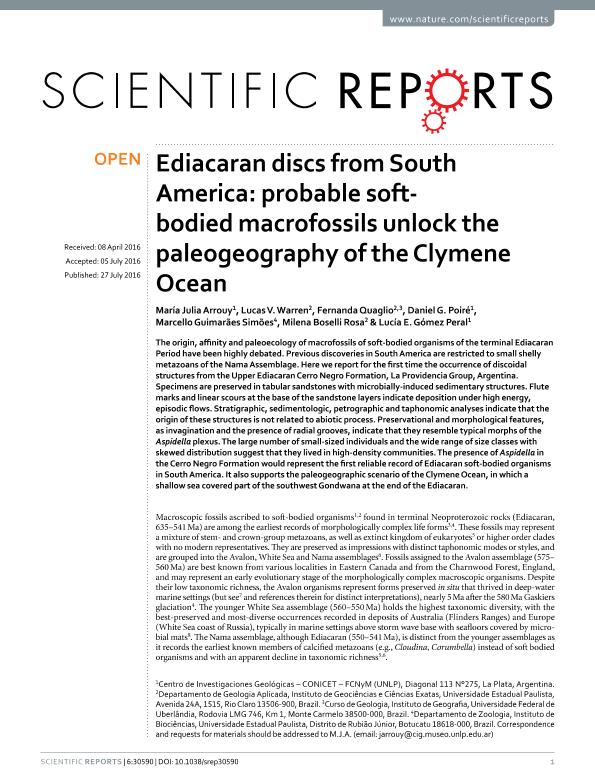Artículo
Ediacaran discs from South America: Probable soft-bodied macrofossils unlock the paleogeography of the Clymene Ocean
Arrouy, Maria Julia ; Warren, Lucas V.; Quaglio, Fernanda; Poire, Daniel Gustavo
; Warren, Lucas V.; Quaglio, Fernanda; Poire, Daniel Gustavo ; Guimarães Simões, Marcello; Boselli Rosa, Milena; Gómez Peral, Lucia
; Guimarães Simões, Marcello; Boselli Rosa, Milena; Gómez Peral, Lucia
 ; Warren, Lucas V.; Quaglio, Fernanda; Poire, Daniel Gustavo
; Warren, Lucas V.; Quaglio, Fernanda; Poire, Daniel Gustavo ; Guimarães Simões, Marcello; Boselli Rosa, Milena; Gómez Peral, Lucia
; Guimarães Simões, Marcello; Boselli Rosa, Milena; Gómez Peral, Lucia
Fecha de publicación:
07/2016
Editorial:
Nature Publishing Group
Revista:
Scientific Reports
ISSN:
2045-2322
Idioma:
Inglés
Tipo de recurso:
Artículo publicado
Clasificación temática:
Resumen
The origin, affinity and paleoecology of macrofossils of soft-bodied organisms of the terminal Ediacaran Period have been highly debated. Previous discoveries in South America are restricted to small shelly metazoans of the Nama Assemblage. Here we report for the first time the occurrence of discoidal structures from the Upper Ediacaran Cerro Negro Formation, La Providencia Group, Argentina. Specimens are preserved in tabular sandstones with microbially-induced sedimentary structures. Flute marks and linear scours at the base of the sandstone layers indicate deposition under high energy, episodic flows. Stratigraphic, sedimentologic, petrographic and taphonomic analyses indicate that the origin of these structures is not related to abiotic process. Preservational and morphological features, as invagination and the presence of radial grooves, indicate that they resemble typical morphs of the Aspidella plexus. The large number of small-sized individuals and the wide range of size classes with skewed distribution suggest that they lived in high-density communities. The presence of Aspidella in the Cerro Negro Formation would represent the first reliable record of Ediacaran soft-bodied organisms in South America. It also supports the paleogeographic scenario of the Clymene Ocean, in which a shallow sea covered part of the southwest Gondwana at the end of the Ediacaran.
Palabras clave:
Ediacaran Fauna
,
Aspidella
,
Precambrian Sedimentology
,
Tandilia System
Archivos asociados
Licencia
Identificadores
Colecciones
Articulos(CIG)
Articulos de CENTRO DE INVEST.GEOLOGICAS (I)
Articulos de CENTRO DE INVEST.GEOLOGICAS (I)
Citación
Arrouy, Maria Julia; Warren, Lucas V.; Quaglio, Fernanda; Poire, Daniel Gustavo; Guimarães Simões, Marcello; et al.; Ediacaran discs from South America: Probable soft-bodied macrofossils unlock the paleogeography of the Clymene Ocean; Nature Publishing Group; Scientific Reports; 6; 7-2016; 1-10
Compartir
Altmétricas



